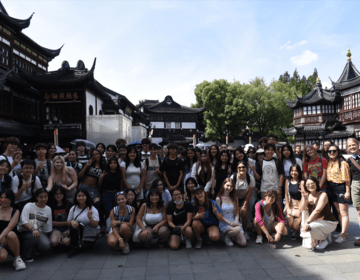Shanghai's Old City
Located in the heart of Shanghai's Old City, Yu Garden (豫园) is a historic site that offers a glimpse into the Ming Dynasty with its classical Chinese architecture, ponds, and landscaped gardens. The surrounding area around Yu Garden and the City God Temple (城隍庙) has been renovated and commercialized, but it still maintains much of its original history — making it a must-visit destination for anyone exploring Shanghai.
Yu Garden's History
Yu Garden was built in the 16th century during the Ming Dynasty by a government officer named Pan Yunduan as a private residence for his aging parents. The name "Yu" (豫) means "peaceful" and "comfort," reflecting the serene atmosphere the garden was meant to offer. Covering five acres, the garden is divided into six general areas laid out in the Suzhou style.
The Student Experience
Our students were given a unique set of tasks to complete, designed to deepen their understanding and appreciation of this historical site. Here’s a glimpse of what their afternoon looked like.
1. Behind the Names
Students were tasked with identifying buildings and finding out the reasons behind their names. For example, they learned about the "Nine Bend Bridge," whose many turns are believed to deter evil spirits, while also symbolizing a journey filled with contemplation and nobility.
2. The Essence of Shanghai
Students were encouraged to find a dish that best represents Shanghai and explain their choice. The most common answer that we got was soup dumplings (小笼包), and many also had the opportunity to try tanghulu (糖葫芦), a popular street snack of candied fruit skewers, for the first time.
3. Meet the Craftsmen
Interviewing local craftsmen gave students a chance to learn about traditional arts and crafts, such as fan-making (which they also made during their first week), and paper-cutting.
4. Market Adventures
Exploring Wenchang Road, students observed the types of goods sold, giving them insights into local commerce and everyday life in Shanghai. The day ended with some shopping, where students bought souvenirs for their loved ones and qipaos (旗袍) for themselves, taking home a piece of Shanghai's vibrant culture.
Related Posts
Wuxi (无锡) - Day 2!
Hanfu (汉服) refers to the traditional clothes worn by the Han ethnic people of China. In ancient times, hanfu was distinguished by social status, occupation, and occasions. Those in the... keep reading

Exploring Shanghai - Visiting Yu Garden and Old City God Temple
On July 18, students visited the Yu Garden (豫园)and the Old City God Temple (城隍庙) in downtown Shanghai. During the excursion, students walked with their peers to explore the history... keep reading